17 July 2024 : Daily Current Affairs
1. With two new judges, Supreme Court back to its full judicial strength
- 1. With two new judges, Supreme Court back to its full judicial strength
- 2. Glimpses of LUCA, the life-form from which all other life descended
- 3. Top court quashes Bihar decision to classify Tanti-Tantwa as SC
- 4. Centre Halts SSA Funds to Delhi, Punjab, and West Bengal Over Non-Participation in PM-SHRI Scheme
- 5. India’s Exports Grow 2.55% in June Amidst Logistics Challenges and Rising Imports
- 6. India Urged to Extend Leadership in Digital Public Infrastructure to Global South, Says G20 Task Force
- (Source: Indian Express; Section: Economy; Page: 15)
- 7. Union Minister inaugurates Asia’s first health research related “Pre-clinical Network facility” under Coalition of Epidemic Preparedness Innovations (CEPI)
- Prelims Facts
- 1. Elephant population in Kerala shows a considerable decline
- 2. ‘1,151-cr. investment can help India in battery tech. race’
- 3. The ABO classification system
- 4. Crude oil imports decline to a four-month low of 18.5 million tonne in June
- 5. Centre reconstitutes NITI Aayog, brings in allies as special invitees
- 6. 6 children die of suspected Chandipura virus infection in Gujarat
(Source – The Hindu, International Edition – Page No. – 5)
| Topic: GS2 – Indian Polity – Judiciary |
| Context |
|
Analysis of the news:
- President Droupadi Murmu appointed Justices N. Kotiswar Singh and R. Mahadevan as Supreme Court judges.
- The five-member Supreme Court Collegium, led by Chief Justice D.Y. Chandrachud, recommended their appointments on July 11.
- The appointments bring the Supreme Court back to its full sanctioned strength of 34 judges.
- Justice Singh is the first judge from Manipur appointed to the Supreme Court, bringing representation to Northeast India. Manipur has been experiencing ethnic violence.
- Justice Singh was serving as the Chief Justice of the High Court for Jammu and Kashmir and Ladakh, and was due to retire on February 28, 2025.
- Justice Mahadevan, from a backward community in Tamil Nadu, is noted for bringing diversity to the Supreme Court Bench.
- The Collegium highlighted Justice Mahadevan’s rank and suitability, prioritising his appointment for representation of the backward community.
- The new appointees replace Justices Aniruddha Bose and A.S. Bopanna, who retired in April and May, respectively.
| Procedure for appointment of Supreme Court Judges: |
|
Constitutional Basis:
Eligibility Criteria:
Collegium System:
Initiation of Process:
Recommendation:
Executive Approval:
Presidential Appointment:
Consultation Process:
Final Appointment:
|
| Tenure and Removal of Supreme Court Judge: |
|
The Constitution has not fixed the tenure of a judge of the Supreme Court. However, it makes the following provisions in this regard:
|
| PYQ: Critically examine the Supreme Court’s judgement on ‘National Judicial Appointments Commission Act, 2014’ with reference to appointment of judges of higher judiciary in India. (150 words/10m) (UPSC CSE (M) GS-2 2017) |
| Practice Question: Examine the tenure and removal process of Supreme Court judges in India. How do these provisions contribute to judicial independence? (150 Words /10 marks) |
2. Glimpses of LUCA, the life-form from which all other life descended
(Source – The Hindu, International Edition – Page No. – 7)
| Topic: GS3 – Science and Technology |
| Context |
|
The Oparin-Haldane Hypothesis and Early Experiments
- The origin of life on Earth remains a profound mystery, with various theories proposed but lacking conclusive proof. Alexander Oparin and J. B. S. Haldane introduced the Oparin-Haldane hypothesis in the 1920s, suggesting that the first molecules of life emerged from a “primordial soup” of inorganic compounds in Earth’s early, volatile environment.
- The Miller-Urey experiment in 1952 supported this hypothesis by demonstrating that amino acids, the building blocks of proteins, could form from inorganic compounds (methane, ammonia, water) under simulated early Earth conditions, including lightning-like electrical discharges.
Other Theories and Recent Discoveries
- Alternative theories propose that meteorites brought organic molecules to Earth, supported by discoveries of extraterrestrial organic material in meteorites and amino acids on asteroids like Ryugu.
LUCA and the Molecular Clock
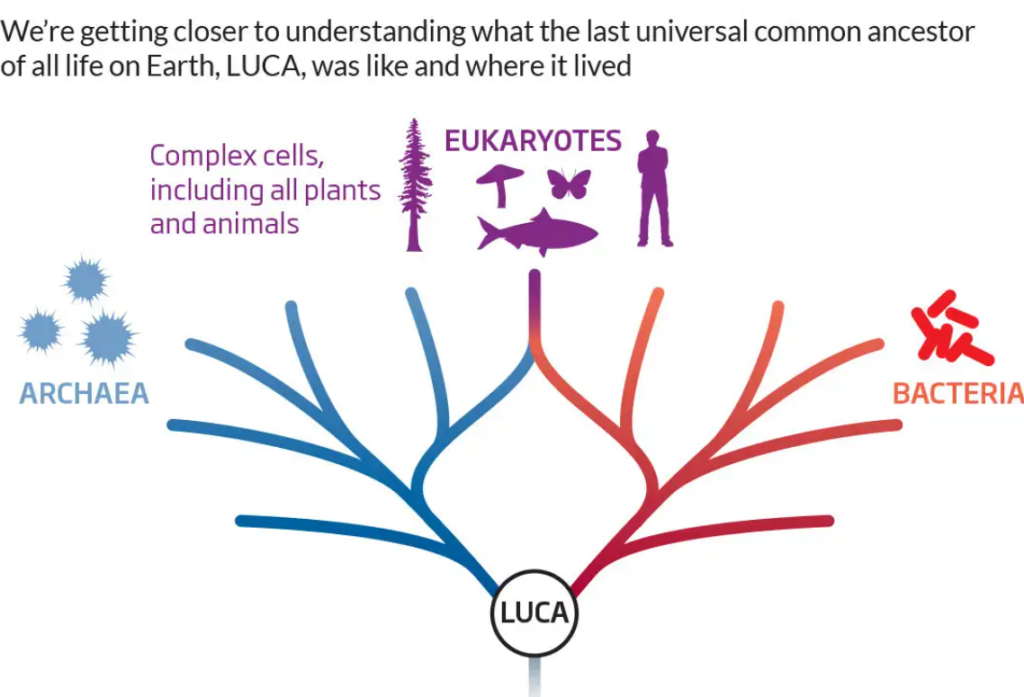
- The Last Universal Common Ancestor (LUCA) theory posits that all life forms — bacteria, archaea, and eukarya — evolved from a single cell. Although no fossil evidence exists for LUCA, genomic similarities across species suggest a common ancestry.
- The molecular clock theory, proposed by Emile Zuckerkandl and Linus Pauling in the 1960s, estimates evolutionary timelines based on mutation rates in genomes. This method uses temporal benchmarks from known evolutionary events to calibrate mutation rates.
Recent Studies and Findings
- A recent study published in Nature Ecology and Evolution used genomic analysis and the molecular clock to estimate LUCA’s origin around 4.2 billion years ago, shortly after Earth’s formation.
- This predates previous estimates and suggests LUCA had a small genome and may have produced metabolites creating a unique ecosystem.
- Fossil records from the Pilbara Craton suggest early life forms emerged around 3.4 billion years ago, whereas LUCA’s estimated origin pushes back by nearly a billion years, indicating life’s early evolution.
- Researchers also speculate LUCA may have possessed genes for immunity, suggesting it had mechanisms to combat viruses, furthering understanding of early microbial interactions.
Significance and Future Implications
- Understanding LUCA’s origins and evolution not only sheds light on Earth’s early life but also informs the search for extraterrestrial life.
- Insights into evolutionary processes enhance efforts to engineer synthetic organisms for industrial and environmental applications on Earth and potentially other planets.
- This research underscores the profound implications for astrobiology and synthetic biology, offering pathways for future exploration and manipulation of biological systems.
| Practice Question: Discuss the Oparin-Haldane hypothesis and its relevance in the context of early Earth conditions, supported by the Miller-Urey experiment. How does recent genomic research using the molecular clock contribute to understanding the origin of LUCA and early life on Earth? (150 Words /10 marks) |
3. Top court quashes Bihar decision to classify Tanti-Tantwa as SC
(Source: Indian Express; Section: Government and politics; Page: 06)
| Topic: GS2 – Polity |
| Context: |
|
Analysis of the news:
Recently, the SC has quashed a 2015 notification of the Bihar government deleting ‘Tanti-Tantwa’ caste from the Extremely Backward Classes (EBC) and merged it with Pan/Sawasi caste in the Scheduled Castes list.
Supreme court’s Verdict:
- The state government had no competence or authority to tinker with the lists of Scheduled Castes published under Article 341 of the Constitution, said a bench of Justices Vikram Nath and Prashant Kumar Mishra said.
- The bench said, the Scheduled Castes list specified under the notification Clause-1 can be amended or altered only by a law made by the Parliament, the bench said.
- As per Article 341 neither the central government, nor the President can make any amendments or changes in the notification issued under Clause-1 without a law made by the Parliament, specifying the castes in relation to the states or Union territory, as the case may be.
- The called the notification “mala fide” and unpardonable “mischief”.
- The bench also stated, that the Commission would have no jurisdiction to make recommendation with respect to any caste being included in the SC lists
- If in case the commissio makes such a recommendation, right or wrong, the State has no authority to proceed to implement the same when it was fully aware that the Constitution does not permit it to do so.
4. Centre Halts SSA Funds to Delhi, Punjab, and West Bengal Over Non-Participation in PM-SHRI Scheme
(Source: Indian Express; Section: Cover Page; Page: 01)
| Topic: GS2 – Government policies – Interventions for development in various sectors. |
| Context: |
|
Analysis of News:
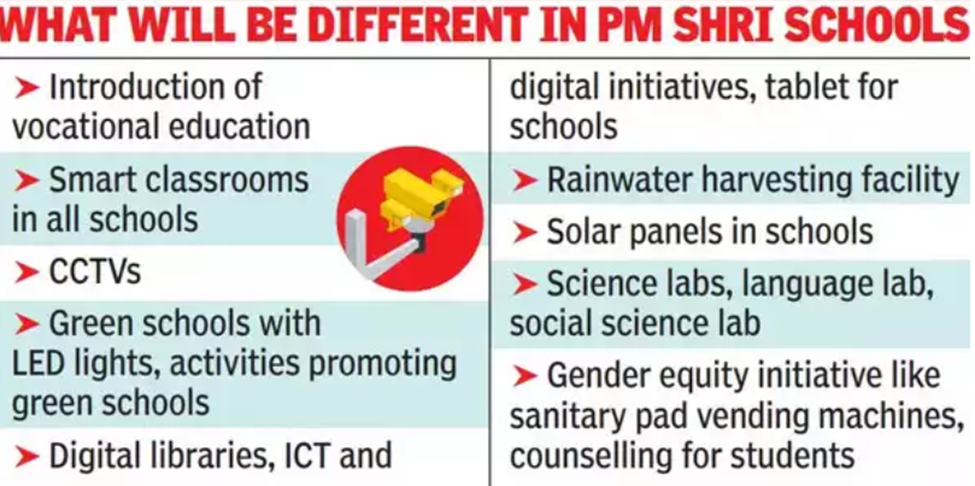
What is Pradhan Mantri Schools for Rising India (PM-SHRI) Scheme?
It is a Centrally Sponsored scheme announced in 2022.
- Objective: Development of more than 14500 schools across the country by strengthening selected existing schools being managed by Central Government/ State/ UT Government/ local bodies.
- The duration of the scheme is from 2022-23 to 2026-27, after which it shall be the responsibility of the States/UTs to continue to maintain the benchmarks achieved by these schools.
Features:
- The selected schools will act as exemplar schools showcasing all components of the National Education Policy 2020 (NEP) and offering mentorship to other schools in their vicinity.
- The PM SHRI Schools will be developed as Green Schools, incorporating environment-friendly aspects.
- The pedagogy adopted in these schools will be more experiential, holistic, integrated, play/toy-based (particularly in the foundational years), inquiry-driven, discovery-oriented, learner-centric, discussion-based, flexible and enjoyable.
- The focus will be on the learning outcomes of every child in every grade.
- Assessment at all levels will be based on conceptual understanding and application of knowledge to real-life situations and will be competency-based.
- Linkage with Sector Skill Councils and local industry for enhancing employability and providing better employment opportunities will be explored.
- A School Quality Assessment Framework (SQAF) is being developed, specifying the key performance indicators to measure outcomes. Quality evaluation of these schools at regular intervals will be undertaken to ensure the desired standards.
States’ Stance on PM-SHRI
- Five states, including Tamil Nadu, Kerala, Delhi, Punjab, and West Bengal, have not signed the MoU for the PM-SHRI scheme.
- While Tamil Nadu and Kerala have shown willingness, Delhi, Punjab, and West Bengal have refused to participate.
- This refusal appears to have prompted the Centre to halt their SSA funds. As a result, these three states have not received the third and fourth installments of SSA funds for the last financial year’s October-December and January-March quarters, nor the first installment for the current financial year’s April-June quarter.
Financial Impact on States
- The stoppage of funds has led to significant financial challenges for the affected states. Delhi is awaiting around Rs 330 crore, Punjab close to Rs 515 crore, and West Bengal over Rs 1,000 crore for the pending quarters.
- The states have sent multiple letters and reminders to the Ministry seeking the release of the pending funds.
- State government officials have expressed concern over the financial strain caused by the fund stoppage, impacting basic school activities and payments, including salaries of teachers and staff.
Conclusion
- The halt in SSA funds to Delhi, Punjab, and West Bengal due to their refusal to participate in the PM-SHRI scheme has caused significant financial difficulties for these states.
- The situation underscores the tension between state and central government initiatives in the education sector, with each side standing firm on their respective policies and schemes.
- The resolution of this issue is crucial for ensuring the smooth functioning and financial stability of school education programs in the affected states.
| Significance |
|
| PYQ: National Education Policy 2020 is in conformity with the Sustainable Development Goal-4 (2030). It intends to restructure and reorient education system in India. Critically examine the statement. (250 words/15m) (UPSC CSE (M) GS-2 2020) |
| Practice Question: Discuss the implications of the Education Ministry’s decision to halt funds under the Samagra Shiksha Abhiyan (SSA) to states that have refused to participate in the Pradhan Mantri Schools for Rising India (PM-SHRI) scheme. Analyze the potential impact on the affected states’ education systems and the broader issues of federalism and state autonomy in India. (250 words/15 m) |
5. India’s Exports Grow 2.55% in June Amidst Logistics Challenges and Rising Imports
(Source: Indian Express; Section: Economy; Page: 15)
| Topic: GS3 – Indian Economy |
| Context: |
|
Analysis of News:
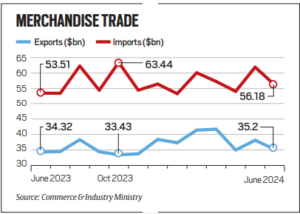
Overview of India’s Goods Exports in June
- India’s goods exports in June witnessed a modest growth of 2.55% year-on-year, reaching $35.2 billion.
- This growth can be attributed to the ongoing demand recovery in significant export markets such as the US and the European Union (EU), supported by a slight easing of inflation in Western countries.
- Despite the positive trend in exports, the trade deficit widened to $20.98 billion from $19.19 billion the previous year, driven by a 20% year-on-year increase in the petroleum import bill.
Exporters Facing Logistics Challenges
- Federation of Indian Export Organisations (FIEO), highlighted the “extraordinary logistics challenges” that exporters are facing.
- These challenges include a shortage of container availability, limited shipping space, irregular shipping schedules, and instances of ships skipping Indian ports.
- It suggested that in the absence of these disruptions, export growth could have approached double digits in June 2024.
Impact of Global Trade Policies
- Indian exporters are also contending with the repercussions of international trade policies.
- There is a significant shortage of containers and shipping space due to Chinese exporters rushing to ship goods ahead of impending US tariffs on Chinese products, effective August 1.
- This shortage is exacerbated by the European Union’s recent imposition of a 37.6% tariff on imports of Chinese electric vehicles, which took effect earlier this month.
- India relies heavily on Chinese-made containers for its exports.
Performance in Key Export Destinations
- India’s exports showed gains in four out of the top five export destinations. Exports to the US increased by 6%, to the UAE by 14%, to the Netherlands by 6%, and to the UK by 13%.
- However, exports to Australia, with which India has a mini free trade agreement (FTA), fell by 18%.
Imports and Trade Sources
- China remains India’s top import source, followed by Russia, the UAE, and the US.
- Imports from China increased by 18.37% in June year-on-year, while imports from Russia rose by 18.57% and from the UAE by 48.15%, reflecting the impact of the FTA signed in 2022.
- Imports from Vietnam and Taiwan surged by 46% and 51%, respectively.
Future Outlook and Sectoral Performance
- Commerce Secretary expressed optimism about India’s export growth, citing positive global growth forecasts and decreasing inflation.
- He projected that if global growth sustains, India’s exports could exceed $800 billion in the current financial year.
- Key growth drivers include engineering goods, electronics, pharmaceuticals, and organic and inorganic goods.
Specific Sectoral Trends
- Spice exports rebounded with an 11.50% increase in June after a decline the previous month.
- Exports in the drugs and pharmaceuticals category grew by 11.58%, engineering goods by 11.93%, and electronic goods by 18.67%.
- Conversely, petroleum products exports decreased by 18.30%, and gems and jewellery exports dipped by 1.42%.
Recommendations for Supporting Exporters
- FICCI emphasized the need for measures to support liquidity, such as deeper interest subvention support and extending the interest equalization scheme for five years.
- It also underscored the importance of addressing Middle East geopolitical issues, ensuring container availability, managing marine insurance, and rationalizing freight charges.
- Additionally, it called for low-cost credit, marketing support, and the swift conclusion of key FTAs with the UK, Peru, and Oman to bolster the export sector.
| PYQ: Account for the failure of manufacturing sector in achieving the goal of labour-intensive exports rather than capital-intensive exports. Suggest measures for more labour-intensive rather than capital-intensive exports. (150 words/10m) (UPSC CSE (M) GS-3 2017) |
| Practice Question: Discuss the recent trends in India’s goods exports and imports for June, focusing on the impact of global demand recovery, logistical challenges, and international trade policies. What measures could be implemented to support Indian exporters amidst these challenges? (250 words/15 m) |
6. India Urged to Extend Leadership in Digital Public Infrastructure to Global South, Says G20 Task Force
(Source: Indian Express; Section: Economy; Page: 15)
| Context: |
|
Analysis of News:
What is a DPI?
- DPI refers to blocks or platforms such as digital identification, payment infrastructure and data exchange solutions that help countries deliver essential services to their people, empowering citizens and improving lives by enabling digital inclusion.
- DPI Ecosystem: DPIs mediate the flow of people, money and information. These three sets become the foundation for developing an effective DPI ecosystem:
- First, the flow of people through a digital ID System.
- Second, the flow of money through a real-time fast payment system.
- And third, the flow of personal information through a consent-based data sharing system to actualise the benefits of DPIs and to empower the citizen with a real ability to control data.
IndiaStack:
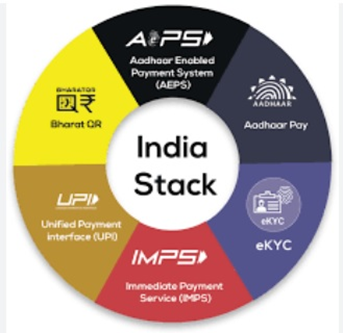
- It is a set of APIs (Application programming interface) that allows governments, businesses, startups and developers to utilise an unique digital Infrastructure to solve India’s hard problems towards presence-less, paperless, and cashless service delivery.
- India, through India Stack, became the first country to develop all three foundational DPIs, Digital identity (Aadhar), Real-time fast payment (UPI) and Account Aggregator built on the Data Empowerment Protection Architecture (DEPA).
- DEPA creates a digital framework that allows users to share their data on their own terms through a third-party entity, who are known as Consent Managers.
ABOUT THE TASK FORCE
- The Task force was established in January 2023 to oversee and facilitate achieving India’s G20 Presidency agenda and priorities on Digital Public Infrastructure (DPI) and Financial Inclusion.
- The Task Force looked at ways G20 member countries can boost productivity by adopting digital technology and DPI across sectors as well as help the government’s digital economy policies and regulations. The composition of the Task Force is given below.
Recommendations from the G20 Task Force
- The final report of India’s G20 Task Force on Digital Public Infrastructure, released by the task force for economic transformation, financial inclusion, and development, outlines several recommendations.
- The report calls for India to identify an existing body that can harness the DPI ecosystem across various regions and countries, with a specific focus on the Global South.
- This body should be of global standard with a multinational presence, capable of working on policy dimensions, strategy formulation, and implementation with appropriate technical and academic expertise.
Responsibilities of the Proposed Body
- The proposed body should promote knowledge sharing on DPI and guide nations through the effective deployment of their resources.
- It should work across various sectors and take responsibility for developing and setting appropriate standards in multiple technical domains of DPI.
- This includes ensuring that the deployment of digital solutions is effective and aligned with global best practices, thereby enhancing the impact of DPI on economic transformation and financial inclusion.
Importance of Global Collaboration
- The report underscores the importance of global collaboration in the DPI sector.
- By taking on a leadership role, India can facilitate the spread of digital public infrastructure to developing countries, helping them leverage these technologies for economic growth and development.
- This collaborative approach can drive innovation and ensure that the benefits of digital transformation are widely shared, particularly among countries in the Global South.
Conclusion
- The G20 task force’s report highlights India’s significant role in the DPI sector and the responsibilities that come with leadership.
- By establishing a global standard body and fostering international collaboration, India can continue to lead in digital public infrastructure, driving economic transformation and financial inclusion worldwide.
7. Union Minister inaugurates Asia’s first health research related “Pre-clinical Network facility” under Coalition of Epidemic Preparedness Innovations (CEPI)
(Source – https://pib.gov.in/PressReleseDetail.aspx?PRID=2033656 )
| Topic: GS2 – Social Justice – Health |
| Context |
|
Analysis of the news:
- Dr. Jitendra Singh inaugurated Asia’s first health research “Pre-clinical Network Facility” at THSTI, Faridabad, under CEPI, capable of handling BSL3 pathogens.
| Coalition for Epidemic Preparedness Innovations (CEPI): |
|
- The facility will facilitate research on Nipah Virus, Influenza, and other respiratory diseases.
- He also inaugurated the “Genetically Defined Human Associated Microbial Culture Collection (Ge-HuMic)” facility, acting as a repository for microbial cultures and genetically characterized specific pathogen-free animals.
- More than a dozen agreements and MoUs were signed with the private sector for vaccine development.
- THSTI, under the Department of Biotechnology, aims to foster national and international collaborations, support translational research, and innovate in fundamental research.
- Dr. Singh highlighted THSTI’s pivotal role during the COVID-19 pandemic and its contribution to vaccine development, emphasizing India’s leadership in preventive healthcare.
| Practice Question: What do you understand by Coalition for Epidemic Preparedness Innovations (CEPI). Discuss the role and significance of the Coalition for Epidemic Preparedness Innovations (CEPI) in global health security. (250 Words /15 marks) |
Prelims Facts
1. Elephant population in Kerala shows a considerable decline
(Source – The Hindu, International Edition – Page No. – 3)
| Context |
|
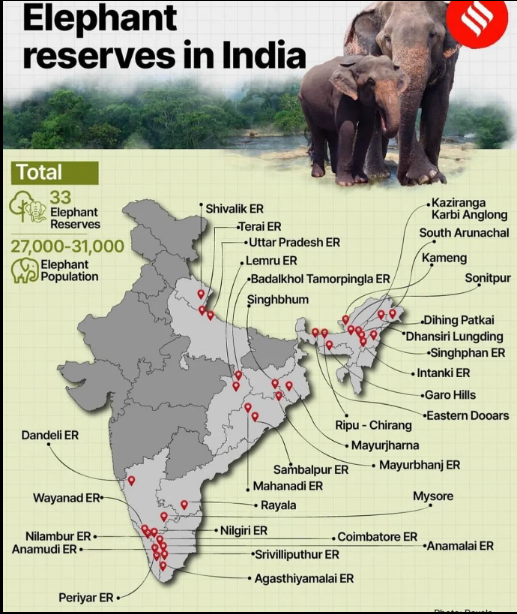
Analysis of the news:
- A recent synchronised elephant population estimation across southern states revealed a decline in Kerala’s elephant count from 1920 last year to 1793 in 2024, with a density of 0.19 elephants per sq.km.
- The Forest Department attributed the decline to “natural variation” due to elephant migration caused by extreme climate conditions.
- Forest Minister A.K. Saseendran released the report, based on assessments conducted from May 23 to 25 in Kerala, Karnataka, Tamil Nadu, and Andhra Pradesh.
- The exercise was part of an Interstate Coordination Committee’s efforts to mitigate human-elephant conflicts.
- Elephant Reserve (ER)-level analysis showed stable populations in Periyar and Nilambur ERs, while Wayanad and Anamudi ERs recorded population reductions of 29% and 12%, respectively.
- Estimated populations in ERs: Anamudi – 615 (previously 696), Nilambur – 198 (previously 171), Periyar – 813 (previously 811), and Wayanad – 178 (previously 249).
- Stable numbers in Periyar and Nilambur attributed to undulating topography and better habitat quality.
- The population drop in Wayanad was influenced by extreme dry periods followed by late summer rains.
2. ‘1,151-cr. investment can help India in battery tech. race’
(Source – The Hindu, International Edition – Page No. – 6)
| Context |
|
Analysis of the news:
- Strategic Investment: A report suggests that a ₹1,151 crore investment over five years can position India as a leader in advanced battery technology for electric vehicles.
- Report Details: Prepared by the Automotive Research Association of India (ARAI) and commissioned by the Office of the Principal Scientific Adviser (PSA) to the Government of India.
- E-mobility R&D Roadmap: Outlines necessary steps to develop advanced battery technology capabilities, divided into four main areas:
- Energy Storage Cells
- Electric Vehicle Aggregates
- Materials and Recycling
- Charging and Refuelling
- Project Timelines: Each area is subdivided into projects with timelines ranging from two to five years, with a cumulative projected cost of ₹1,151 crore.
- Purpose: The roadmap is strategic, aiming to ensure India does not fall behind in the global battery technology race. The roadmap aims to reduce India’s dependence on imported lithium batteries, despite known domestic lithium reserves yet to be fully exploited.
- Current Dependency: At present India’s electric vehicle fleet relies heavily on imported lithium batteries.
- Domestic Lithium Reserves: Large lithium reserves have been announced but are yet to be exploited; the government has allowed private sector mining of these minerals.
3. The ABO classification system
(Source – The Hindu, International Edition – Page No. – 7)
| Context |
|

Blood Group
ABO Blood Group System:
- Human blood contains red blood cells (RBCs) with antigens A and/or B on their surfaces.
- Antigens A and B determine blood group types: A, B, AB, and O.
- Antibodies in the serum (antibody-A and antibody-B) react with opposite antigens to agglutinate (clump) RBCs.
- Blood group A has antigen-A on RBCs and antibody-B in serum.
- Blood group B has antigen-B on RBCs and antibody-A in serum.
- Blood group AB has both antigens A and B on RBCs and no antibodies in serum.
- Blood group O has neither antigen A nor B on RBCs but has both antibodies in serum.
Compatibility and Transfusion:
- Group A can receive blood from A and O groups.
- Group B can receive blood from B and O groups.
- Group AB is the universal recipient (can receive blood from all groups).
- Group O is the universal donor (can donate blood to all groups).
Rh Blood Group System:
- Rh factor (antigen D) determines Rh-positive (+) or Rh-negative (-) blood types.
- Rh-positive individuals have antigen D on RBCs.
- Rh-negative individuals lack antigen D on RBCs.
Conclusion:
- Blood types are determined by ABO and Rh systems, crucial for transfusion compatibility.
- ABO system categorises blood into A, B, AB, and O based on antigens and antibodies.
- The Rh system distinguishes Rh-positive and Rh-negative blood types based on the presence of antigen D.
4. Crude oil imports decline to a four-month low of 18.5 million tonne in June
(Source – The Hindu, International Edition – Page No. – 12)
| Context |
|
Analysis of the news:
- Crude Oil Imports: India’s crude oil imports in June hit a four-month low at 18.5 million tonnes, down 15% month-on-month and nearly 6% year-on-year, following a record-high procurement of 21.8 million tonnes in May.
- Supplier Dynamics: Despite increased imports from Russia, traditional suppliers Iraq and Saudi Arabia saw declines both annually and monthly.
- U.S. Imports: Crude oil imports from the U.S. have been rising since March, driven by favourable market conditions and price arbitrage compared to West-Asian grades.
- Demand Outlook: India’s robust economic growth and positive manufacturing outlook are expected to boost oil product demand. OPEC forecasts a growth of 0.2 mb/d year-on-year on average in the second half of 2024, driven by initiatives supporting manufacturing and household consumption.
- Jet Fuel Demand: With the addition of more airport terminals and recovery in air travel, India’s jet fuel demand is expected to surge, outpacing other transport fuels in the 2024 fiscal year.
- Cyclone activity and above-average rainfall forecasts for the monsoon season could dampen agricultural and construction activities, potentially affecting oil demand in the third quarter of 2024.
5. Centre reconstitutes NITI Aayog, brings in allies as special invitees
(Source: Indian Express; Section: Cover Page; Page: 01)
| Context: |
|
Analysis of the new:
- The National Institution for Transforming India, known as NITI Aayog, was constituted in 2015 when the PM Modi-led NDA government chose to scrap the Planning Commission.
- The government reconstituted the NITI Aayog, increasing the number of special invitees from five to 11
- It encompasses five ministers from the BJP’s allies, whereas Prime Minister Narendra Modi remains the Chairperson and economist Suman K Bery will continue to be the Vice Chairperson of NITI Aayog.
- Now, the composition includes:
Composition of NITI Aayog:
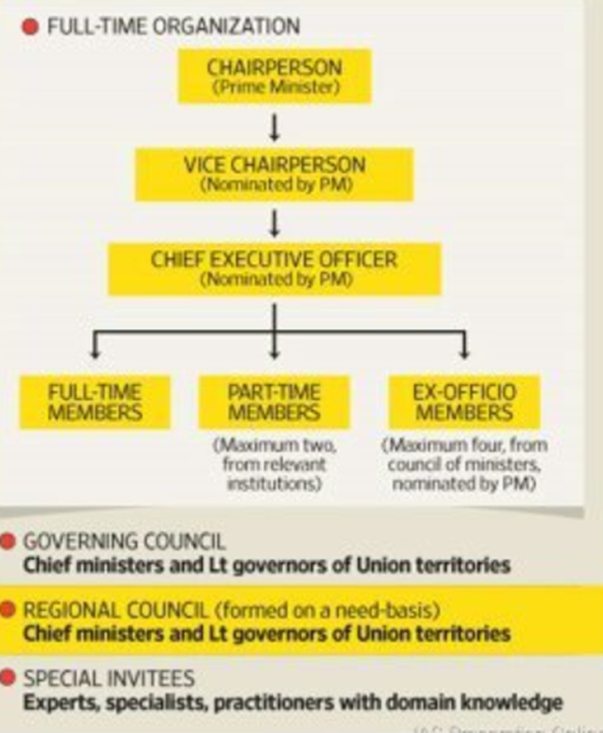
Chairperson: PM Modi
Vice-chairperson: Economist Suman K Bery
Chief Executive Officer: BVR Subrahmanyam
Full members:
- Scientist V K Saraswat
- Ramesh Chand
- V K Paul
- Arvind Virmani
Ex-officio members:
- Finance Minister Nirmala Sitharaman
- Home Minister Amit Shah
- Defence Minister Rajnath Singh
- Agriculture Minister Shivraj Chouhan
Special Invitees:
- H D Kumaraswamy (JD-S)
- Jitan Ram Manjhi (HAM)
- Rajiv Ranjan Singh (JD-U)
- K R Naidu (TDP)
- Chirag Paswan (LJP-Ram Vilas)
- Nitin Gadkari
- Jagat Prakash Nadda
- H D Kumaraswamy
- Jitan Ram Manjhi
- Rajiv Ranjan Singh alias Lalan Singh
6. 6 children die of suspected Chandipura virus infection in Gujarat
| Context: |
|
Analysis of the News:
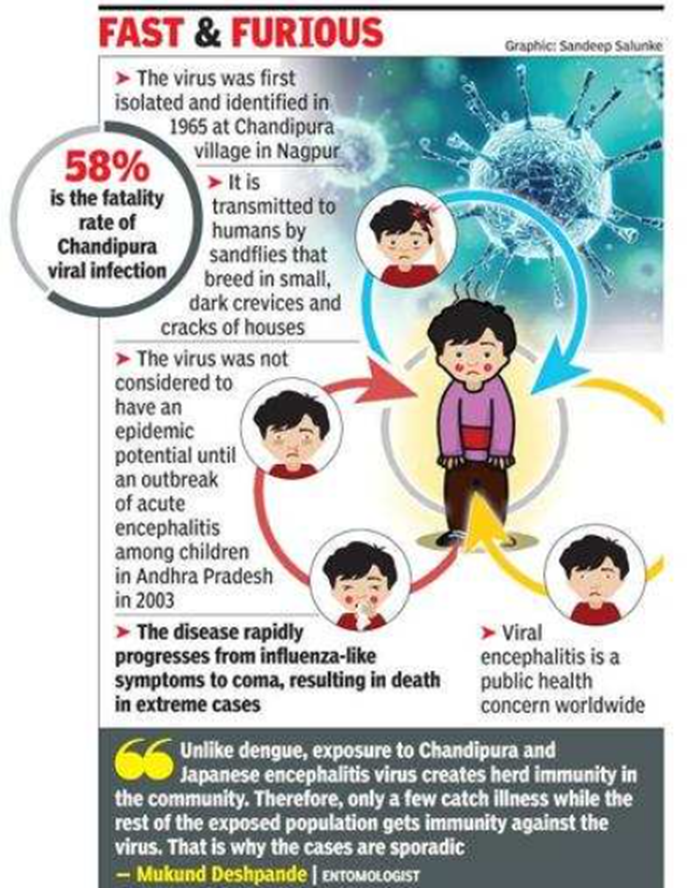
The state government has logged at least 12 cases of the infections, the samples have been sent to Pune’s National Institute of Virology (NIV) for confirmation, Gujarat Health Minister Rushikesh Patel said on Tuesday.
Origin:
In 1965, the first time the Chandipura virus was identified in India. This led to it being named as ‘Chandipura’ based on the district of the same name in Maharashtra’s Nagpur, where it was first found.
What is the Chandipura virus?
- Chandipura virus is a mosquito-borne disease causing fever, mostly affecting children between the ages of nine months and 14 years.
- It can be spread by ticks and sand flies, and occurs during the rainy season, particularly in the rural regions.
What is CHPV infection and how is it transmitted?
- CHPV is a virus of the Rhabdoviridae family, which also includes other members such as the lyssavirus that causes rabies.
- The virus resides in the salivary gland of these insects, and can be transmitted to humans or other vertebrates like domestic animals through bites.
- The infection caused by the virus can then reach the central nervous system which can lead to encephalitis — inflammation of the active tissues of the brain.
What are the symptoms of CHPV infection?
Initially, symptoms occurs such as acute onset of fever, body ache, and headache. It may then progress to altered sensorium or seizures and encephalitis.
How can the infection be managed?
There is no vaccine available for the treatment. As a result, it becomes crucial to manage brain inflammation to prevent mortality.

